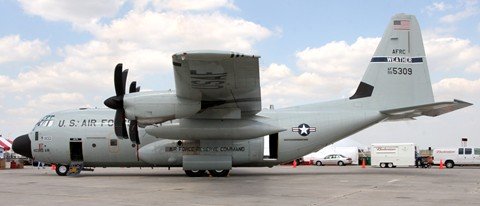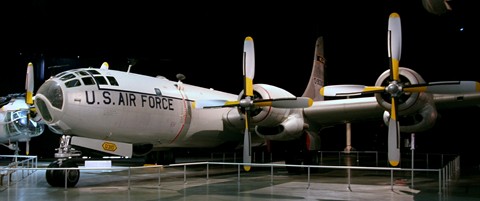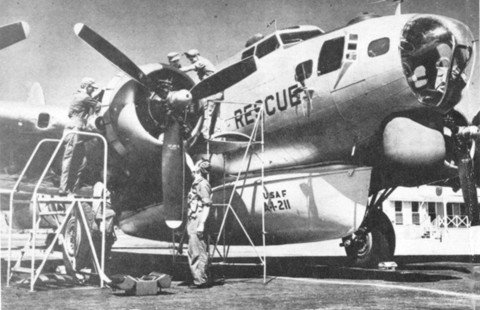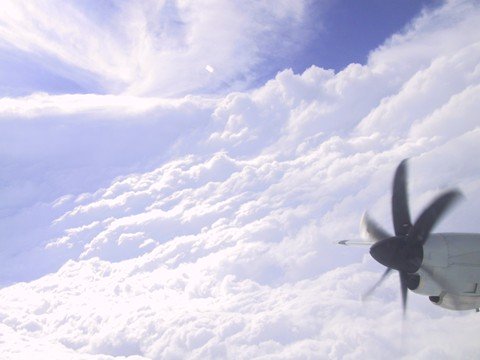|
53rd WRS Hurricane Hunters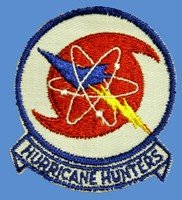
The 53rd WRS (Weather Reconnaissance Squadron), better known as the ‘Hurricane Hunters’, is a United States Air Force squadron of aircraft based in Biloxi, MS, that flies missions into hurricanes and weather systems for research purposes and observation. These Hurricane Hunters of the Air Force Reserve should not be confused with the NOAA Hurricane Hunters, based at MacDill AFB, Tampa, Florida, who use their WP-3D Orion and Gulfstream IV-SP aircraft for their missions. BackgroundAlthough satellite data has revolutionized weather forecasters' ability to spot signs of tropical cyclones before they form, there are still many important tasks for which it is not suited. Satellite imagery cannot determine the interior barometric pressure of a hurricane, nor can it provide accurate information about wind speeds. These data are needed by forecasters to accurately predict a hurricane's development and movement. The area of responsibility for the Hurricane Hunters is midway through the Atlantic Ocean to the Hawaiian Islands. The Air Force Reserve Hurricane Hunters have also been tasked to fly into typhoons in the Pacific Ocean on occasion, as well as gather data in winter storms.
Because satellites cannot collect the data, and ships are both too slow and too vulnerable to endure large storm waves, the only viable way to collect this data is with aircraft. Thus, the 53rd WRS, which is part of the 403rd Air Wing, has the task of flying instrument laden WC-130J aircraft, like the one shown above (99-5309), into storms to collect the required meteorological data. The AircraftThe WC-130J Hercules aircraft is a venerable workhorse aircraft with four turboprop engines. The aircraft's purpose is to fly directly into the hurricane, typically penetrating the hurricane's eye several times in one mission at no higher than 10,000 feet and no lower than 500 feet. The 53rd WRS operates ten WC-130J aircraft for weather reconnaissance. Besides the Hercules, other aircraft have been used to investigate hurricanes, including an instrumented Lockheed U-2 that was flown in Hurricane Ginny during the 1963 Atlantic hurricane season. Other aircraft that have been used over the years:
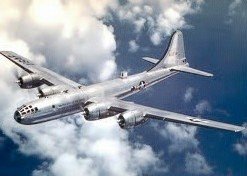
RB-17, 1945-1946 TB-17, 1945-1947 B-25, 1946-1947 B-29, 1946-1947 WB-29, 1951-1956 WB-50, 1956-1960 WB-50, 1962-1963 WB-47, 1963-1969 C-130, 1965 WC-130B,E,H, 1965-1991 RC-130, 1974-1975 HC-130, 1976 WC-130H, 1993-2005 WC-130J, 2005-present
You will notice gaps in the dates above. This is due to several reasons, most of which have to do with a lack of structure in weather recon duties. Not all of these duties fell to the Air Force with some duties performed by the Navy, and some by NOAA. Another reason is that some years did not have an active storm season. And we can’t forget that ever popular reason - budget cuts. Since 1993, when the 53rd WRS was reactivated as an Air Force reserve unit, US weather recon responsibilities are more structured. The USAF performs certain tasks and the NOAA performs others, with the most important aspect is that they work together. First Flight of the Hurricane HuntersFlying aircraft into hurricanes started with a bet. In 1943 a surprise hurricane struck Houston, Texas. That summer, British pilots were being trained in instrument flying at Bryan Field. When they saw that the Americans were evacuating their AT-6 Texan trainers in the face of the storm, they began questioning the construction of the aircraft. 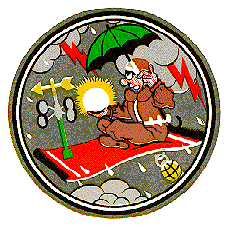
Lead instructor Colonel Joe Duckworth took one of the trainers out with navigator Lt. Ralph O'Hair aboard, and flew it straight into the eye of the storm. After he returned safely, the base's weather officer, Lt. William Jones-Burdick, took over the navigator's seat and Duckworth flew into the storm a second time. Thus the legacy of the Hurricane Hunters began with a dare. Pictured to the right is an early hurricane hunter patch. History of the 53rd WRSThe 53rd WRS began life in 1944 as the 30th Weather Reconnaissance Squadron flying out of Gander, Newfoundland. Their mission was to fly weather tracks from North America to Allied Western Europe. In 1946, the moniker ‘Hurricane Hunters’ was first used, and the Air Force have used it ever since. Today's Hurricane Hunters are staffed with Air Force Reserve personnel. From Gander the weather squadron began a global journey that lasted for 30 years before settling at their current home at Keesler AFB, MS, in 1976. Some of the stops along the way included Kindley Field, Bermuda; Burtonwood Royal Air Force Station, England; Durhan, Saudi Arabia; Ramey AFB, Puerto Rico; and Hunter AFB, GA. In June 1991, the 53rd was inactivated and all weather reconnaissance became the responsibility of the 815th Weather Squadron. The 815th had coexisted with the 53rd since 1976. On November 1, 1993, the 53rd WRS was reactivated and assigned to the Air Force Reserve. B-17 to the RescueIn the mid-1940s the B-17 was used not only for weather reconnaissance, but for rescue as well. The photo below, courtesy of the USAF, shows the rescue arrangement. Yes, that’s a lifeboat mounted to the bottom of the aircraft. The boat was launched just like a bomb.
On one such rescue a B-17 was dispatched during a hurricane to rescue men in a fishing boat that was sinking. When the aircraft arrived at the site, the bombardier released the boat, but only the front latch released, with the back of the boat still hung up on a latch. As it swung about wildly it hit a propeller and destroyed it. To launch the boat, a crew member had to go into the bomb bay with an axe and cut the latch as the pilot and copilot wrestled with the plane to keep it from plummeting into the ocean. Despite a close call, the plane was spared from a watery grave. Swan 38In 1974, a newly converted WC-130 (65-0965) was transferred to the 54th Weather Reconnaissance Squadron, the "Typhoon Chasers", at Andersen Air Force Base on Guam. The aircraft was sent to investigate Typhoon Bess. The crew departed Clark Air Base in the Philippines with the call sign “Swan 38.” Radio contact with the aircraft was lost on October 12, 1974, apparently as the aircraft was heading into the typhoon's eye to make a second position fix. There were no radio transmissions indicating an emergency on board, and search teams could not locate the aircraft or its crew. All six crew members were listed as KIA. Swan 38 is one of only a handful of Hurricane Hunter flights lost, and the only WC-130 to go down in a storm. Hurricane Katrina
The landfall of Hurricane Katrina on August 29, 2005 caused devastating damage to Keesler Air Force Base, home base of the 53rd Weather Reconnaissance Squadron. In anticipation of the storm, the equipment and personnel of the squadron were temporarily moved to Dobbins Air Reserve Base near Atlanta. Despite heavy losses, the squadron never missed a tasked mission from the National Hurricane Center. The 53rd WRS has long since returned to Keesler and is now once again flying weather reconnaissance missions from the base. Return to top of this 53rd WRS page.
|
